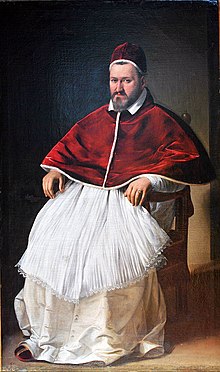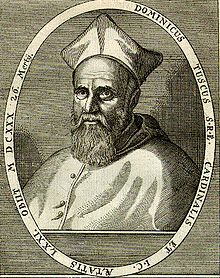The papal conclave of May 1605 was convened on the death of Pope Leo XI and ended with the election of Camillo Borghese as Pope Paul V on 16 May 1605. It was the second of two papal conclaves in 1605, with Leo dying on 27 April 1605, twenty-six days after he was elected in the March–April 1605 papal conclave.

Pope Nicholas II had reserved the right to elect the pope to the cardinal bishops, priests, and deacons of Rome in 1059.[2] The cardinal bishops were the highest rank, being the bishops of the ancient suburbicarian dioceses. Cardinal priests ranked next, serving as the titular head of historically important churches in Rome. Last ranked the cardinal deacons, who were nominally assigned one of the ancient diaconia where traditionally deacons had administered the material possessions of the Church of Rome. Cardinals were required to have been ordained at least to the rank of their order within the College of Cardinals, but could also be ordained to a higher order.[3]
In 1586, Pope Sixtus V had mandated that the maximum number of cardinals be seventy.[4] Of these, the College of Cardinals had sixty-nine total members at the time of Clement VIII's death.[5][6] Following Leo's election, Girolamo Agucchi had also died on 27 April, the same day as Leo, reducing the total number of cardinals in the College by two.[7] The electors present had been created by six different popes: Pius IV, Gregory XIII, Sixtus V, Gregory XIV, Innocent IX, and Clement VIII. Clement's creations were the most numerous, as he had created thirty-nine of the cardinal electors. Innocent IX had created one of the conclave's electors, Gregory XIV had created five, Sixtus V had created eleven, Gregory XIII had created three, and Pius IV had created one.[8][i]
Cardinal electors
Fifty-nine total cardinals entered the conclave, and Paolo Emilio Zacchia and Carlo Gaudenzio Madruzzo participated in the conclave, assenting to the final vote, but did not enter the proceedings because they were sick.[9][10]

| Name | Rank[9][ii] | Created cardinal by[8] | Nationality | Sources |
|---|---|---|---|---|
| Tolomeo Gallio | Bishop | Pius IV | Italian | [12] |
| François de Joyeuse | Bishop | Gregory XIII | French | [13] |
| Domenico Pinelli | Bishop | Sixtus V[iii] | Italian | [14] |
| Girolamo Bernerio | Bishop | Sixtus V[iii] | Italian | [14] |
| Agostino Valier | Priest | Gregory XIII | Italian | [15] |
| Antonio Maria Gallo | Priest | Sixtus V | Italian | [14] |
| Antonmaria Sauli | Priest | Sixtus V | Italian | [16] |
| Benedetto Giustiniani | Priest | Sixtus V | Italian | [17] |
| Giovanni Evangelista Pallotta | Priest | Sixtus V | Italian | [16] |
| Federico Borromeo | Priest | Sixtus V | Italian | [16] |
| Francesco Maria del Monte | Priest | Sixtus V | Italian | [16] |
| Gregorio Petrocchini | Priest | Sixtus V | Italian | [18] |
| Mariano Pierbenedetti | Priest | Sixtus V | Italian | [18] |
| Paolo Emilio Sfondrati | Priest | Gregory XIV | Italian | [19] |
| Ottavio Paravicini | Priest | Gregory XIV | Italian | [19] |
| Ottavio d'Aquaviva d'Aragona | Priest | Gregory XIV | Italian | [19] |
| Flaminio Piatti | Priest | Gregory XIV | Italian | [20] |
| Giovanni Antonio Facchinetti de Nuce[iv] | Priest | Innocent IX | Italian | [21] |
| Pietro Aldobrandini | Priest | Clement VIII | Italian | [22] |
| Francesco Maria Tarugi | Priest | Clement VIII | Italian | [22] |
| Ottavio Bandini | Priest | Clement VIII | Italian | [22] |
| Anne d'Escars de Givry | Priest | Clement VIII | French | [22] |
| Giovanni Francesco Biandrate di San Giorgio Aldobrandini | Priest | Clement VIII | Italian | [23] |
| Camillo Borghese[v] | Priest | Clement VIII | Italian | [23] |
| Caesar Baronius | Priest | Clement VIII | Italian | [23] |
| Lorenzo Bianchetti | Priest | Clement VIII | Italian | [23] |
| Francisco de Ávila | Priest | Clement VIII | Spanish | [23] |
| Francesco Mantica | Priest | Clement VIII | Italian | [23] |
| Pompeio Arrigoni | Priest | Clement VIII | Italian | [23] |
| Bonifazio Bevilacqua Aldobrandini | Priest | Clement VIII | Italian | [23] |
| Alfonso Visconti | Priest | Clement VIII | Italian | [24] |
| Domenico Toschi | Priest | Clement VIII | Italian | [24] |
| Paolo Emilio Zacchia[vi] | Priest | Clement VIII | Italian | [25] |
| Franz von Dietrichstein | Priest | Clement VIII | German | [24][26] |
| Robert Bellarmine | Priest | Clement VIII | Italian | [24] |
| François de Sourdis | Priest | Clement VIII | French | [24] |
| Séraphin Olivier-Razali | Priest | Clement VIII | French | [27] |
| Domenico Ginnasi | Priest | Clement VIII | Italian | [27] |
| Antonio Zapata y Cisneros | Priest | Clement VIII | Spanish | [27] |
| Filippo Spinelli | Priest | Clement VIII | Italian | [24] |
| Carlo Conti | Priest | Clement VIII | Italian | [24] |
| Carlo Gaudenzio Madruzzo[vi] | Priest | Clement VIII | German[vii] | [27] |
| Jacques Davy Duperron | Priest | Clement VIII | French | [24] |
| Innocenzo del Bufalo-Cancellieri | Priest | Clement VIII | Italian | [24] |
| Giovanni Delfino | Priest | Clement VIII | Italian | [24] |
| Giacomo Sannesio | Priest | Clement VIII | Italian | [5] |
| Girolamo Pamphili | Priest | Clement VIII | Italian | [5] |
| Ferdinando Taverna | Priest | Clement VIII | Italian | [5] |
| Anselmo Marzato | Priest | Clement VIII | Italian | [5] |
| Erminio Valenti | Priest | Clement VIII | Italian | [5] |
| Francesco Sforza | Deacon | Gregory XIII | Italian | [13] |
| Alessandro Peretti di Montalto | Deacon | Sixtus V | Italian | [28] |
| Odoardo Farnese | Deacon | Gregory XIV | Italian | [29] |
| Cinzio Passeri Aldobrandini | Deacon | Clement VIII | Italian | [22] |
| Bartolomeo Cesi | Deacon | Clement VIII | Italian | [23] |
| Andrea Baroni Peretti Montalto | Deacon | Clement VIII | Italian | [23] |
| Alessandro d'Este | Deacon | Clement VIII | Italian | [24] |
| Giovanni Battista Deti | Deacon | Clement VIII | Italian | [24] |
| Silvestro Aldobrandini | Deacon | Clement VIII | Italian | [22] |
| Giovanni Andrea Doria | Deacon | Clement VIII | Italian | [5] |
| Carlo Emanuele Pio di Savoia | Deacon | Clement VIII | Italian | [5] |
Notes
Citations
References
- Baumgartner, Frederic J. (2003). Behind Locked Doors. Palgrave Macmillan. ISBN 978-0-312-29463-2.
- Boudinhon, Auguste (1911). . In Chisholm, Hugh (ed.). Encyclopædia Britannica. Vol. 5 (11th ed.). Cambridge University Press. pp. 321–323.
- "Cardinal Odoardo Farnese (Biographical details)". The British Museum. Retrieved 10 May 2018.
- Cardella, Lorenzo (1793). Memorie storiche de' cardinali della santa romana Chiesa [Memories of the Cardinals of the Holy Roman Church] (in Italian). Vol. V. Rome: Stamperia Pagliarini. OCLC 42022804.
- Freiherr von Pastor, Ludwig (1952) [1899]. Graf, Ernest (ed.). The History of the Popes. Vol. XXV. London: B. Herder Book Co. OCLC 221543126.
- Eubel, Konrad; van Gulik, Wilhelm (1913). Hierarchia catholica medii et recentioris aevi [The Catholic Hierarchy of the Middle and Recent Ages] (in Latin). Vol. 3. Monasterii Sumptibus et typis librariae Regensbergianae. OCLC 55180223.
- Giannini, Massimo Carlo (2015). "Piatti, Flaminio". Dizionario Biografico degli Italiani [The Italian Biographical Dictionary] (in Italian). 83.
- Gauchat, Patrick (1960). Hierarchia catholica medii et recentioris aevi [The Catholic Hierarchy of the Middle and Recent Ages] (in Latin). Vol. 4. Monasterii Sumptibus et typis librariae Regensbergianae. OCLC 55180223.
- Herbermann, Charles George; Pace, Edward Aloysius; Pallen, Condé Bénoist; Shahan, Thomas Joseph; Wynne, John Joseph (1913). The Catholic Encyclopedia: An International Work of Reference on the Constitution, Doctrine, Discipline, and History of the Catholic Church. Vol. 10. Encyclopedia Press.
- Hsia, R. Po-Chia (2005). The World of Catholic Renewal, 1540–1770. Cambridge University Press. ISBN 978-0-521-84154-2.
- Martinich, A.P. (1999). Hobbes: A Biography. Cambridge University Press. ISBN 9780521495837.
- Pattenden, Miles (2017). Electing the Pope in early modern Italy, 1450–1700. Oxford: Oxford University Press. ISBN 978-0-19-879744-9. OCLC 980220999.
- Squarzina, Silvia Danesi (1997). "The Collections of Cardinal Benedetto Giustiniani. Part I". The Burlington Magazine. 139 (1136): 766–791. JSTOR 887781.









